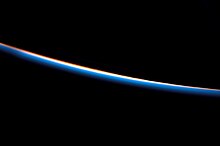
Back أفق Arabic افق ARZ Horizonte AST Chhaqachhaqa Aymara Üfüq Azerbaijani Офоҡ Bashkir Гарызонт Byelorussian Гарызонт BE-X-OLD Хоризонт Bulgarian দিগন্ত Bengali/Bangla

The horizon is the apparent curve that separates the surface of a celestial body from its sky when viewed from the perspective of an observer on or near the surface of the relevant body. This curve divides all viewing directions based on whether it intersects the relevant body's surface or not.
The true horizon is a theoretical line, which can only be observed to any degree of accuracy when it lies along a relatively smooth surface such as that of Earth's oceans. At many locations, this line is obscured by terrain, and on Earth it can also be obscured by life forms such as trees and/or human constructs such as buildings. The resulting intersection of such obstructions with the sky is called the visible horizon. On Earth, when looking at a sea from a shore, the part of the sea closest to the horizon is called the offing.[1]
The true horizon surrounds the observer and it is typically assumed to be a circle, drawn on the surface of a perfectly spherical model of the relevant celestial body, i.e., a small circle of the local osculating sphere. With respect to Earth, the center of the true horizon is below the observer and below sea level. Its radius or horizontal distance from the observer varies slightly from day to day due to atmospheric refraction, which is greatly affected by weather conditions. Also, the higher the observer's eyes are from sea level, the farther away the horizon is from the observer. For instance, in standard atmospheric conditions, for an observer with eye level above sea level by 1.8 metres (6 ft), the horizon is at a distance of about 4.8 kilometres (3 mi).[2] When observed from very high standpoints, such as a space station, the horizon is much farther away and it encompasses a much larger area of Earth's surface. In this case, the horizon would no longer be a perfect circle, not even a plane curve such as an ellipse, especially when the observer is above the equator, as the Earth's surface can be better modeled as an oblate ellipsoid than as a sphere.